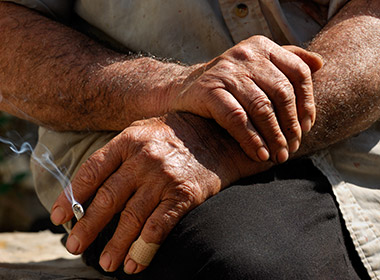Health Equity
Health is shaped by where we live, learn, work, and play. Some people in our community experience more sickness, injury, and disease compared to others. The Ontario Public Health Standards direct health units to improve the health of the entire community with a focus on populations that have greater health needs.
Poor health costs us all. Injury and sickness can limit people’s ability to work and participate in their community. The gap between the health of those who are best off and those worst off is large and damaging to our society. Understanding the factors that affect health helps to show areas where positive changes can be made. Watch this short video to learn more about determinants of health (used with permission from Wellesley Institute).
- Childhood experiences
- Housing conditions
- Access to healthy and affordable food
- Job security and working conditions
- How much money you have
- Access to health services
- Level of education
- Access to safe, affordable, and reliable transportation
Health equity is the idea that all people should have fair opportunities to reach their full health potential. This does not mean that everyone should have equal health. Instead, health equity means creating opportunities for those facing barriers to reaching better levels of health. When everyone has the chance to live their healthiest life, we are all better off.
Some people in our community experience lower levels of health as compared to the general population. These differences are called health inequities when they are caused by unfair and avoidable social, political, and economic conditions. Addressing health inequities is good for local social and economic prosperity.

Children living in low income households are at higher risk to experience physical and mental health challenges. Because of this, they are often less ready to perform their best at school. Latest census data shows that 24% of children in Windsor and Essex County live in a low income household1, 2.

People who work in the skilled trades and manufacturing are more likely to be exposed to second hand smoke. This puts this group at higher risk of developing heart disease, type 2 diabetes, cancer, and chronic obstructive pulmonary disease3.

Between 2007-2017 rates of emergency room visits in Windsor and Essex County related to self-harm were 53.1% higher for women as compared to men4.
For more information, please contact us
The Windsor-Essex County Health Unit works with the community to promote, protect, and improve health and well-being for all. Our programs and services are guided by community needs and aim to address factors and conditions that result in lower levels of health. To make positive changes, we work with community partners, politicians, health care providers, educators, and others to promote health equity in our community.
We are committed to ensuring that every person in our community has access to opportunities that lead to health and better quality of life.
The Windsor-Essex County Health Unit has implemented a corporate Health Equity Strategy aimed at:
- Setting direction and supporting organizational strategic priorities around health equity.
- Promoting principles, practices, and policies outlined in the Ontario Public Health Standards.
- Outlining a shared understanding of equity focused approaches.
- Advancing opportunities to measure and share organizational successes.
- Simplifying decision-making by outlining specific areas for action.
- Supporting enhanced communication and collaboration.
The strategy was designed to evolve over time, enabling the WECHU to leverage organizational strengths, resources, and opportunities. The strategy is reviewed and updated each year to keep it relevant and useful. The annual review process includes action planning for the following year.
To request a copy of the Health Equity Strategy, please use one of the ways listed in the contact us section of our website.
Monitoring and reporting progress enhances the ability to detect meaningful changes over time, promotes continuous quality improvement, and increases opportunities for strategic and targeted action.
A measurement and reporting plan has been established for the Windsor-Essex County Health Unit’s Health Equity Strategy. It focuses on advancing objectives in our Strategic Plan.
Strategic Plan Objective 4.4
Develop and implement protocols that ensure all programs are using health equity approaches.
Corporate Measure
% of programs that have adopted a health equity approach.
Progress
Currently 68% of our programs have adopted a health equity approach.
Everyone can help promote the health of our community by increasing opportunities for groups experiencing health inequities. Here are a few ways that you can help:
Focus on factors that influence health
Promote actions and policies that make it easier for everyone to live a healthier life. For example, support municipal policies that improve physical environments like trails, sidewalks, and good lighting in neighbourhoods.
Focus on reducing barriers
Invest more in programs and services for those experiencing lower levels of health, and those struggling to participate in services. For example, explore opportunities to eliminate or reduce fees for those in financial need.
Focus on evidence
Use and share data that identifies groups in our community experiencing health inequities and those struggling to participate in programs and services. For example, include local data in internal and external reports and use this data to help meet community needs.
Focus on collaboration
Health is greatly influenced by factors outside of the healthcare sector. It’s important to work across sectors to tackle the root causes of sickness and poor health. For example, collaborations between the municipal government, social service providers, law enforcement, emergency medical services, healthcare agencies, grass-roots organizations, and others have helped improve service coordination and outcomes for people experiencing homelessness in Windsor and Essex County.
Focus on inclusion
Include people facing barriers to being healthy in service planning and decision-making. For example, develop a community advisory group for your organization that includes those with lived experience.
Please see the following resources to learn more about health equity and the factors that influence health:
Locally
- Let’s Start a Conversation About Health video
- Health Equity Toolkit and Practical Guide
- Pathway to Potential - Social Investment Windsor-Essex
Provincially
- Ontario’s Chief Medical Officer of Health Report
- Ministry of Health and Long-Term Care Health Equity Guidelines
- Wellesley Institute
Nationally/Internationally
References
- [1] Statistics Canada. 2017. Census in Brief: Children living in low-income households. Statistics Catalogue no 98-200-X. Ottawa, Ontario. September 2017
- [2] Ruiz, J., Quackenboss, J.J., & Tulve, N.S. (2016). Contributions of a child’s build, natural, and social environments to their general cognitive ability: a systematic scoping review. Public Library of Science One, 11(2), e0147741. doi: 10.1371/journal.pone.0147741
- [3] Smoke-Free Ontario Scientific Advisory Committee, Ontario Agency for Health Protection and Promotion (Public Health Ontario). Evidence to guide action: Comprehensive tobacco control in Ontario (2016). Toronto, ON: Queen's Printer for Ontario; 2017.
- [4] Windsor-Essex County Health Unit. (2018). Intentional Self-Harm 2007-2017 Report. Windsor, Ontario.

